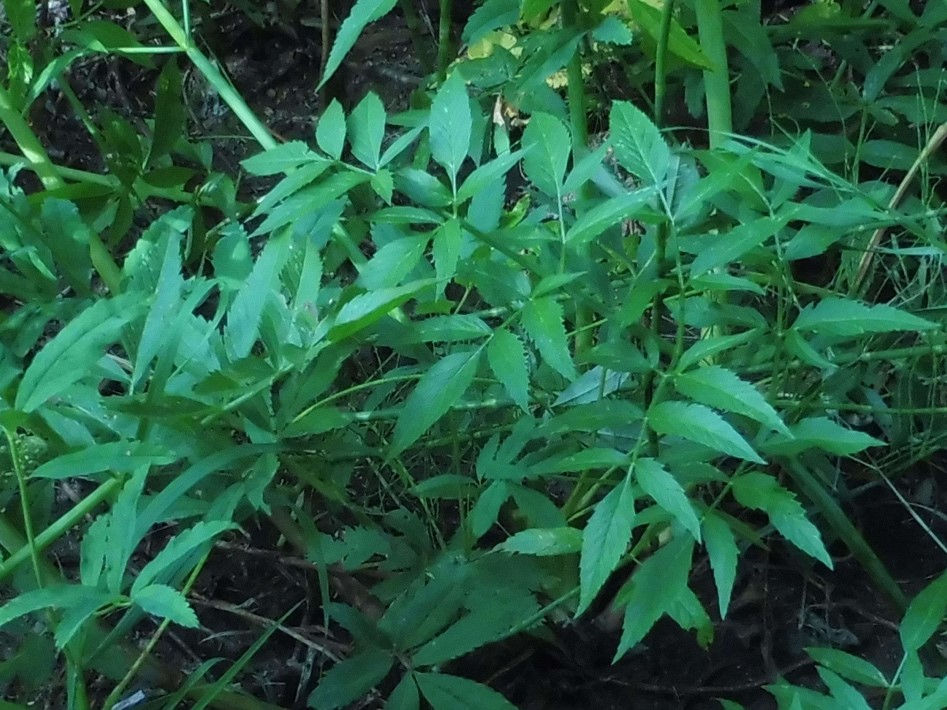Watch out for deadly water hemlock
- Laura Duncan
- Apr 25, 2020
- 2 min read
Water hemlock is one of the deadliest poisonous plants in North America. It is important to learn how to identify it visually -- if you mistake water hemlock for a look-alike plant such as water parsnip or sharp-tooth angelica, you can be accidentally poisoned.

Leaves of the water hemlock (photo by L Duncan)
The Douglas’s water hemlock (Cicuta douglasii) is the most toxic plant found in the Kimberley Nature Park. All parts of this plant are poisonous, but the roots are especially lethal. Following ingestion the toxin, cicutoxin, affects the body's central nervous system causing seizures, delirium, nausea, convulsions, abdominal pain and vomiting. Even a small mouthful can kill an adult, and many livestock animals have died after grazing on it.
As you might expect from its name, water hemlock is found in wet places such as marshes, ditches and stream edges. Within the nature park, water hemlock can be found along Summer Trail around the wetland between the Halfway Cabin near Dipper Lake and the beginning of Talus Trail in Horsebarn Valley. Keep a close eye on your pets in this area. If you know of any other locations of water hemlock in the Kimberley Nature Park, please let us know.
To identify water hemlock, look for the distinguishing characteristics outlined below:

Veins end in the notches between the teeth of each leaflet (photo by L. Duncan)
The compound leaves of water hemlock divide several times into many lance-shaped, sharp-toothed leaflets. The side veins end in the notches between the teeth of each leaflet.

Purplish stems of water hemlock (photo by L. Duncan)
The stems emerge from a tuberous and chambered base and are often purplish. The stems have flat-topped umbels of white flowers, and the seeds are either egg-shaped or circular, with rounded backs.

Umbels of white flowers topping each stem (photo by wildwoodsurvival.com)

Water hemlock seeds can be egg-shaped, or circular (photo by L. Duncan)
While the water hemlock is the most toxic plant to be found in the Kimberley Nature Park, other plants can also cause harm. Depending on dosage and stage of growth, some of these plants can be used either as toxins or as medicinal herbs. All of the following plants should be approached and used with caution:
Baneberry (Actaea rubra) – berries, foliage and roots are highly poisonous. Two berries can cause bloody diarrhea, cardiac arrest, or respiratory system paralysis
Meadow death-camas Zigadenus venenosus) – leaves can cause ??? to grazing stock; the mashed bulbs were used as arrow poison by Okanagan and St’at’imac tribes
Water parsnip (Sium suave) – young plants are considered edible, while older plants are considered toxic to humans and livestock
Common snowberry (Symphocarpus albus) – some indigenous groups considered the plant poisonous, but also used it to treat diarrhea
Rosy twisted stalk (Streptopus roseus) – Nlaka’pmx used this plant for medicine but other interior groups considered it inedible or poisonous
Meadow rue (Thalictrum occidentale)- contains the cardiac poison thalistrine but the Nlaka’pmx used it as a tonic and a wash to remove stiffness
Indian hellebore (Veratrum viride) – all parts are poisonous to humans and livestock, causing stomach cramps, blurred vision, frothing at mouth, lockjaw, vomiting and diarrhea































